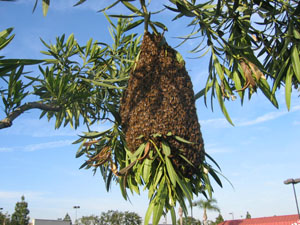Helpful Information about Swarms & Bee Hive Removal Service

A swarm on a tree branch.
The Number 1 Question is:
Will they leave on their own?
In the case of a Swarm, usually YES. A swarm of bees may stop to rest on just about anything during the migratory process and leave between 1 and 72 hours later. In Southern California, the swarming season occurs mostly during Spring and Fall, but it can occur at other times of the year as well.
Established Colonies will NOT leave once they have set up housekeeping except in extenuating circumstances. Bees may choose various hollow cavities to set up colonies such as your roof, eaves, wall voids, water meter boxes, even a BBQ grill or a birdhouse. It only takes bees about 72 hours to start producing honey and combs once they move in.
So the Number 2 Question is:
Can I get rid of these unwanted visitors myself?
Bee Busters does not recommend self-treatment of a bee infestation. An active colony of honey bees can have 10,000 to 60,000 bees in it. What you see on the outside is only a miniscule fraction of what is under the surface. Spraying an active Colony with any ‘over-the-counter’ substance bought at the local hardware store will give the bees reason to become defensive. Also, this method will only exterminate a small fraction of the problem.
When dealing with a Swarm the only self-treatment that Bee Busters recommends is to have patience and let nature run its course. A swarm that has landed on something that does not provide them with a suitable nesting place will not usually stay. Swarms may land on tree branches and the like. Spraying a swarm with water or another substance can cause quite a ruckus and the bees will usually settle back down on the same spot. As with a colony, attempting to self-exterminate your visitors with any method can cause defensive behavior. If a swarm on your property makes you uncomfortable and waiting for nature is not a possibility, give us a call!
Note: Spraying a swarm with water or other substance can damage the queen bee. If she is unable to travel your visitors will stay longer than usual. They won’t leave without her!
Awareness
- Look Up
- Know common nesting places
- Teach children to be respectful of all bees
- Observe. Listen for buzzing and look for signs of bees following a constant path
- Use care. Don’t disturb a nest or a swarm
- Bees around your garden are pollinating and do not pose a threat. Be respectful, they are simply grocery shopping and our environment needs them.
Prevention
- Remove possible nesting sites from the area around your home (empty containers such as flower pots, old tires, BBQ grills, vehicles, cavities in fences, ground and trees)
- Inspect outbuildings, eaves, chimneys and crawl spaces frequently.
- See our Photo Gallery to view some of these common nesting sites
- Seal openings larger than 1/8” in walls, around plumbing and other structural gaps
- Install screens where openings cannot be sealed
- Avoid wearing colognes and scented soaps as well as overusing citrus cleansers

The barbs on a bee’s stinger will lodge in the skin. A stinger can continue to pump venom even after the bee has detached for about a minute.
- If pursued by bees, seek shelter indoors or in vehicle. Bees will respond to the CO2 you exhale and follow it
- Do NOT jump into water
- Protect your eyes and face if being stung. Protect your hair. Don’t swat at bees – it makes them more aggressive
- Remove stingers quickly – if possible scrape them off rather than squeezing them
- Wash the sting(s) with soap
- Apply ice
- Seek medical attention if stung numerous times or if allergic to bee stings
- When possible, move small pets to shelter
- If an animal has multiple stings or appears to have a reaction to a bee sting consult your veterinarian
- Keep animals from eating dead bees. Be aware that dead bees’ stingers can still sting for several days until completely dehydrated.
Call Bee Busters today if you need swarm, colony, or bee hive removal service.


